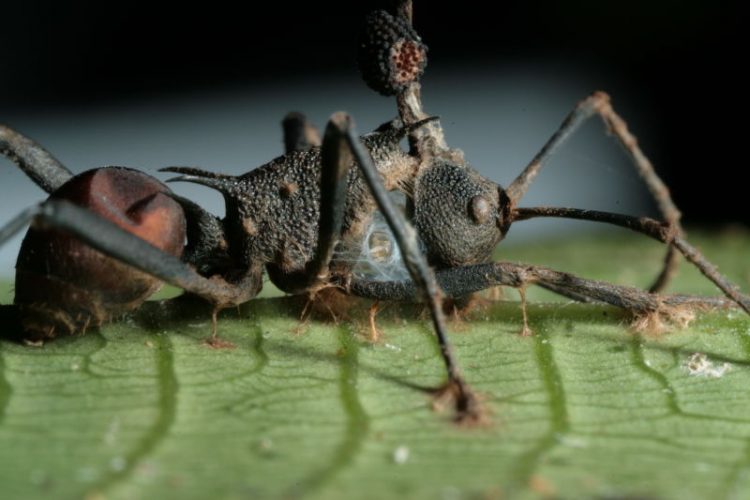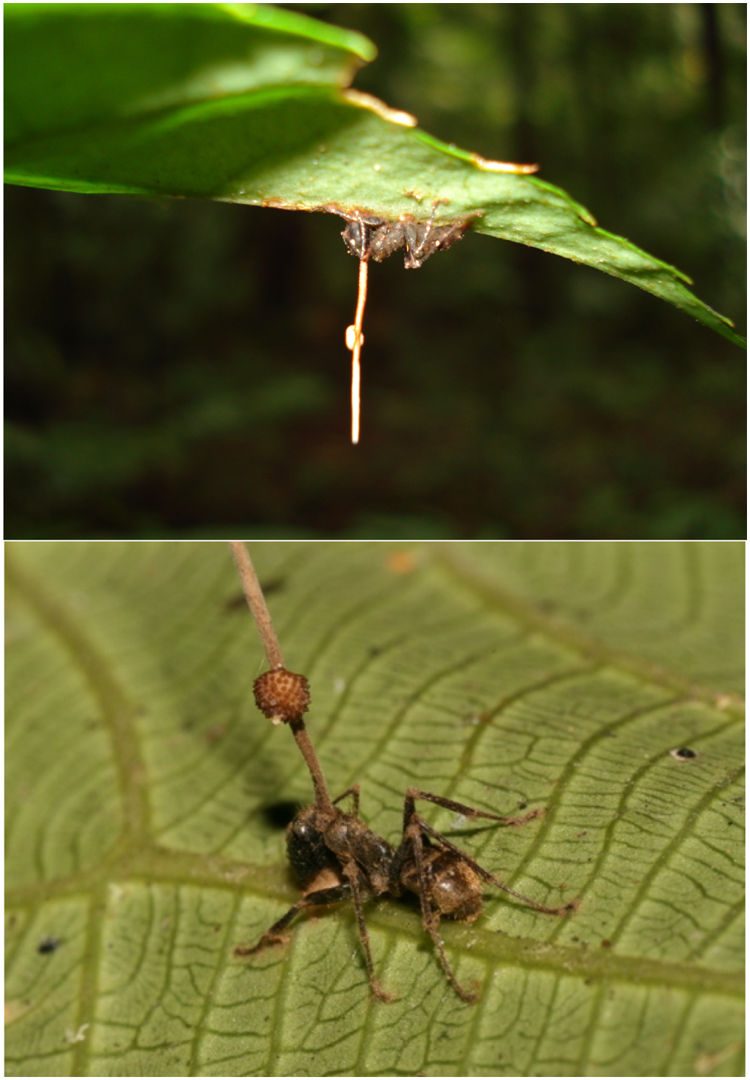A parasitic fungus, of the genus Ophiocordyceps, uses carpenter ants to complete its life cycle by turning them into zombies. The ant encounters the fungal spores while foraging and the fungus quickly infects and spreads throughout its body, hijacking the insect’s nervous system. It then forces the ant to climb vegetation, where it will clamp onto the underside of a leaf or twig, and then slowly die. The parasite then produces a spore-releasing stalk that sprouts from the cadaver’s head to discharge spores to the ground below, where more hapless ants can get infected.
Until recently scientists were uncertain as to the exact mechanisms or reasons behind this gruesome phenomenon. New research from Penn State University, however, has shed some light on the mystery. The researchers have suggested that the fungus invades muscles fibers throughout the insect’s body, which allows it to control the host’s behavior, but stays away from its brain.

Photo: David Hughes/Penn State University
The researchers created 3D images to visualize and understand the movements of the fungi inside the ant. They then used AI and machine-learning algorithms to analyze the images and found that the parasite had spread throughout the entire body of the ant. The fungal cells formed a network and then collectively controlled the ant’s behavior. The brain, however, was left intact, which initially puzzled researchers.
“Normally in animals, behavior is controlled by the brain sending signals to the muscles, but our results suggest that the parasite is controlling host behavior peripherally,” David Hughes, the senior author of the study, said. “Almost like a puppeteer pulls the strings to make a marionette move, the fungus controls the ant’s muscles to manipulate the host’s legs and mandibles.”
“We hypothesize that the fungus may be preserving the brain so the host can survive until it performs its final biting behavior – that critical moment for fungal reproduction. But we need to conduct additional research to determine the brain’s role and how much control the fungus exercises over it,” Hughes added.

Photo: David Hughes/Maj-Britt Pontoppidan
Why the fungus stays away from its victim’s brain, or how it can steer the ants toward a leaf are still mysteries to be solved, but previous research has shown that the fungus may be using a chemical cocktail to alter the insect’s brain.
“Behavioral manipulation is such a complex [characteristic] that it only occurs when there’s a very close coevolution between pathogen and host,” Charissa de Bekker, a molecular biologist and lead author of an older study on the fungus, told Live Science in 2014. “The theory is that every species of ant has its own species of fungi that it gets infected by.”
“We took the four species of ants that we used for the injection study, dissected their brains and kept [the brains] alive by putting them in an insect cell culture medium,” de Bekker said. “We added the fungus to this medium and let it react to the environment, and then we extracted the medium, which had all of the molecules the fungus produced.”
The results showed that the medium from each insect contained thousands of chemicals, many of which were previously unknown. By cross-referencing data from the control groups, researchers were able to identify which compounds were produced by the parasite. They were surprised to learn that the fungus created a unique chemical cocktail for each species, suggesting that it is familiar with the brains of its target hosts. It did not co-evolve with the other two species and was thus unable to produce the right mixture to control them.
The team tested this theory by injecting fungal spores into four ant species, two known hosts, and the other two, Camponotus pennsylvanicus and Formica dolosa, which weren’t known to host the fungus despite being from the same region as the other ants. They also ran control experiments, in which they injected ants with a fungus-free liquid, or left them alone. The fungus killed three of the species, but only the two known hosts succumbed to the mind control. The fourth species, F. dolosa, did not survive the injection treatment and were thus unable to be infected.
So, if having a parasitic fungus take control of your actions wasn’t bad enough, we now know that the helpless host is actually controlled not via the brain, but directly through its muscles, like a puppet. It’s then forced to clamp down on a leaf and await its gruesome end while spore-releasing stalks grow from its body. Let’s hope this thing never takes a liking to humans.






